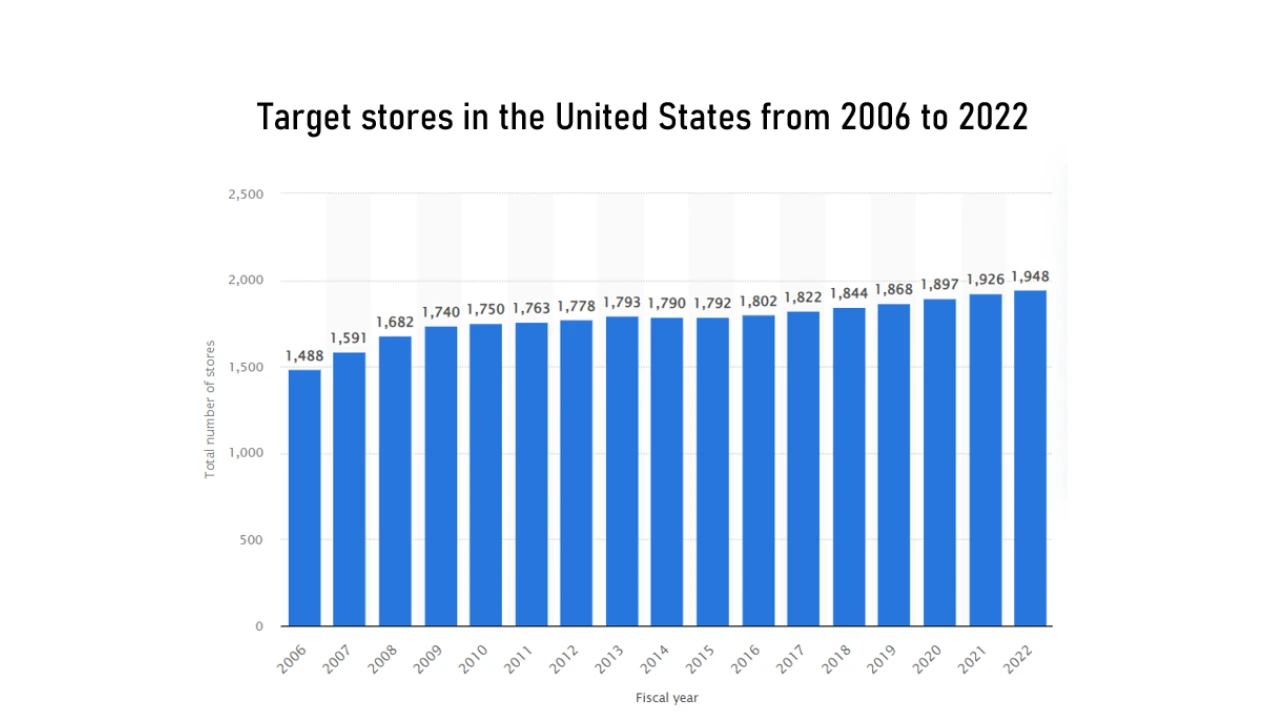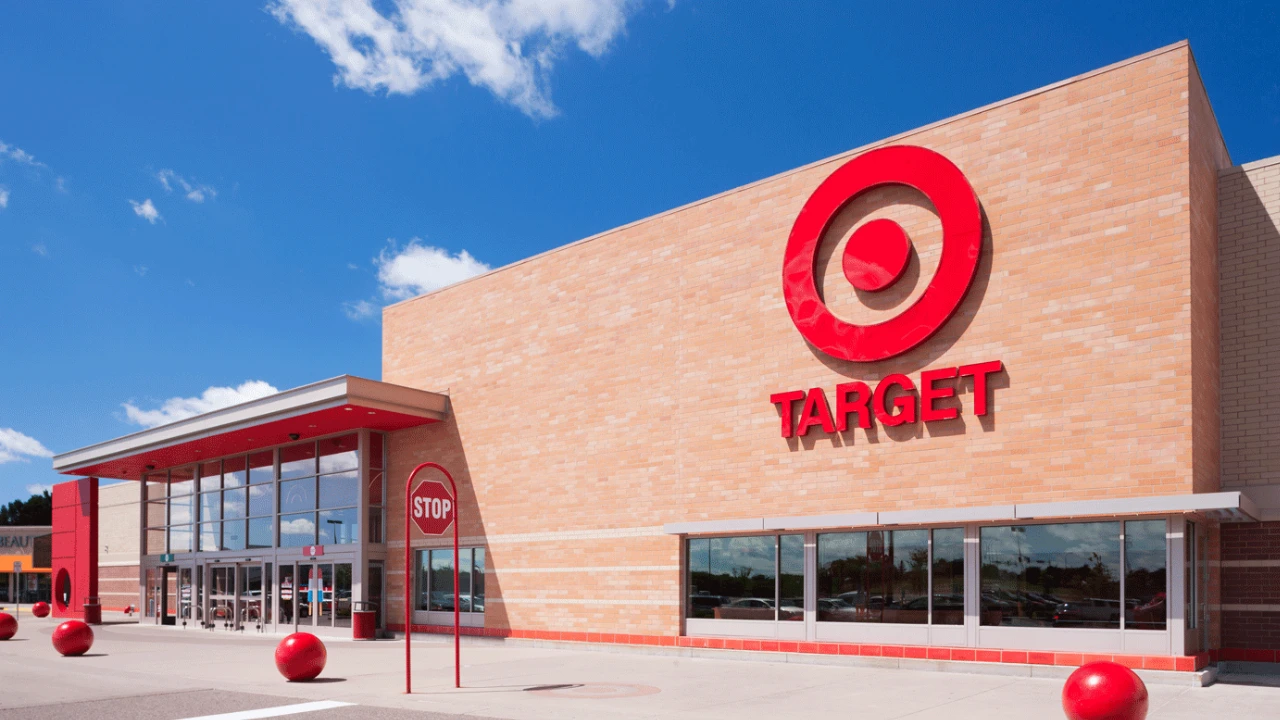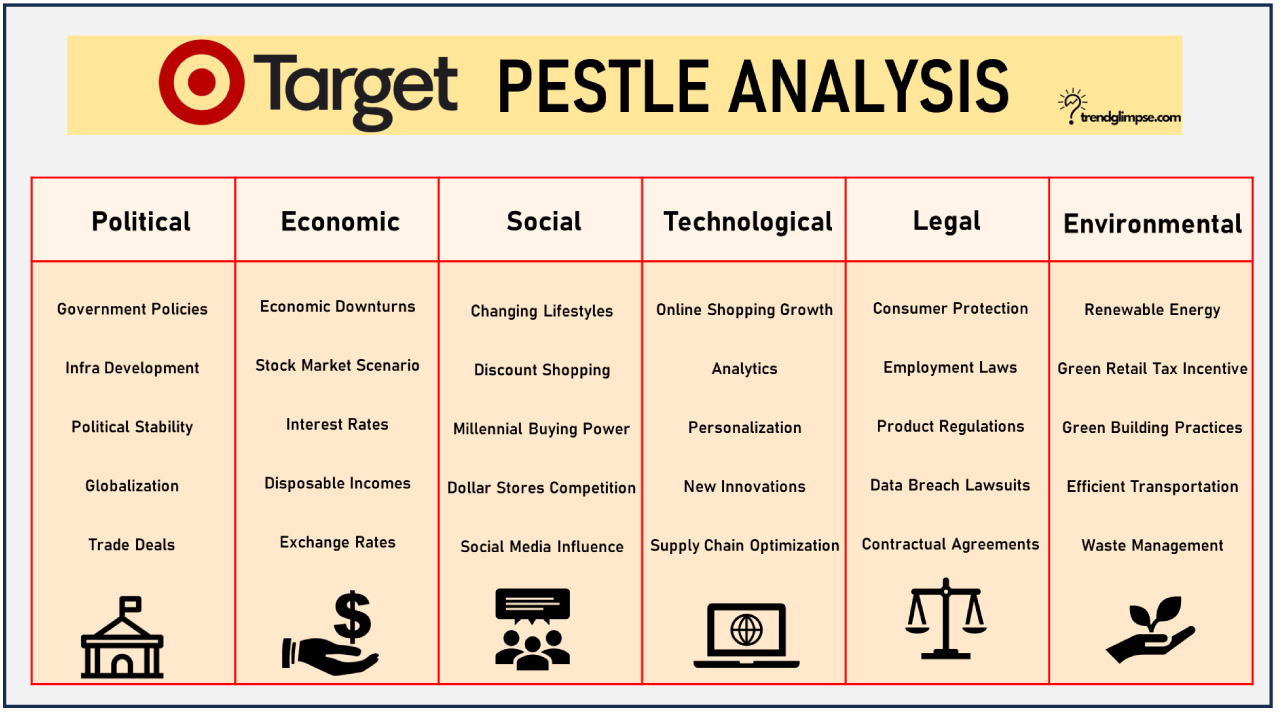Overview of Target
Target is one of the largest retailers in the United States, recognizable by shoppers across the country for its bullseye logo. With nearly 2,000 stores nationwide, Target has become a fixture in American shopping centers thanks to convenient locations, popular private-label brands, and a focus on affordability.
In terms of finances, Target continues to perform well as a publicly-traded company. For fiscal year 2022 (which ended January 29, 2022), Target reported total revenue of $106 billion. This marked a 13.2% increase over the previous year’s total revenue, indicating healthy and steady growth coming out of the pandemic. The company’s profitability also remains strong, with over $8 billion in operating income and nearly $6.9 billion in net earnings for 2022.
Headquarters: Target Plaza, Minneapolis, Minnesota, United States
Industry: Retail
Current CEO: Brian C. Cornell
Annual Revenue [2023]: US$ 106 Billion
Employee Count: ~440,000
Website: target.com
Driving these robust financials is Target’s in-store pickup and same-day delivery services. By offering convenient omnichannel shopping options, Target has adapted to the rise in online spending and increased digital demand.
As a result, as per data from October 2023, Target’s comparable digital sales accounted for 17.1% of total sales on top of significant e-commerce growth in prior years during the pandemic. Paired with over 2 billion total in-store shopper visits last year, Target’s blended channel strategy continues fueling revenue.
Apparel And Accessories (Clothing, Shoes, And Accessories), Beauty And Personal Care Products, Electronics And Entertainment (Televisions, Computers, Video Games), Home And Furniture Items, Toys And Games, Groceries And Household Essentials, Health And Wellness Products, Automotive And Hardware Supplies, Sports And Outdoor Equipment, Jewelry And Watches, Pet Supplies, Baby And Nursery Products, Stationery And Office Supplies, And Seasonal And Holiday Items
Brand Portfolio of Target
Women’s Apparel and Accessories (A New Day, All in Motion, Art Class, Auden, AVA & VIV, Colsie, JoyLab, Knox Rose, Kona Sol, Original Use, Shade & Shore, Stars Above, Universal Thread, Xhilaration, Wild Fable), Wine (California Roots, Casa Cantina, The Collection, Headliner, Jingle & Mingle, Rosé Bae, Photograph, SunPop), Food (Favorite Day, Good & Gather, Market Pantry), Others (Casaluna, Cat & Jack, Cloud Island, Figmint, Goodfellow & Co, etc)
Competitors of Target
Walmart, Amazon, Costco, Kohl’s, Wegmans, Best Buy, Dollar General, Walgreens, Home Depot, Wayfair, Lowe’s, Kroger, Macy’s, JCPenney, Bed Bath & Beyond, and CVS Health.
Going forward, we can expect Target’s top and bottom lines to continue expanding over the next several years. The company is well positioned to compete in an evolving retail landscape while retaining the value, variety, and convenience which has defined its big-box stores for decades. With sound supply chain infrastructure and a sharp consumer focus, Target’s financial growth story seems poised to persist.
Target PESTLE Analysis will allow us to identify any major threats or opportunities that Target faces from its macroenvironment. From this Target PESTLE Analysis, Target may be better equipped to adapt its business strategy to these external influences.
Political Factors Impacting Target
Government Policies
Government policies can have a major effect on a company’s operations and profitability. For example, regulatory changes, tax reforms, or incentive programs could either support or restrict business activity. If new policies aim to encourage growth in a company’s industry, it may present opportunities to expand.
However, increased regulations or taxes could also pose challenges to maintaining margins. Target need to closely track upcoming policy reforms to predict and adapt to shifts that will significantly impact revenues or costs.
Infrastructure Development
In terms of infrastructure development, the modernization of transportation networks, digital connectivity, power grids, and other systems facilitates efficient business processes. Upgraded infrastructure lowers operating expenses, opens access to new markets, and enables innovation.
Still, a lack of investment in infrastructure can risk slowing productivity and growth. As such, Target should assess the state of infrastructure relevant to logistics, communications, and operations. Areas lagging in development may present vulnerabilities or bottlenecks for future performance.
Stability Political Environment
Regarding political stability, civil unrest, regime change, and conflict can greatly limit a company’s ability to safely operate in a market and plan for the future. Volatility due to political tensions makes forecasting and strategic decision-making difficult.
It can be prudent to diversify geographic revenue streams in case adverse events significantly disrupt any single market’s profitability. Target should continually gauge the level of stability in key locations – improvements may support expansion while increased instability requires risk mitigation tactics.
Trade Deals and Globalization
Trade policy also hugely influences cross-border business activity. Fair deals enabling transparent, rules-based trade facilitate specialization, supply chain integration, and access to international partners and customers.
However, restrictive deals or trade wars hamper a company’s flexibility and diversification options which could leave operations exposed. Updated trade agreement analysis is essential to adapt logistics, supply chains and global operations to new barriers or opportunities in key export markets for long-term resilience.
Economic Factors Affecting Target
Economic Downturns or Recessions
Such factors can significantly lower consumer spending power and dampen demand for many businesses. Reduced revenues from a shrinking customer base may require cost-optimization measures like streamlining operations and deferring expansion plans.
For example, a recession may necessitate closing underperforming locations or discontinuing specific product lines until purchase volumes recover. Monitoring economic trends helps model contingency plans if a prolonged slowdown arises.
Stock Market Scenario
Stock market conditions also mirror broader economic stability and outlooks for future performance. Market volatility or a major downward correction can negatively sway consumer confidence.
This could inhibit big-ticket purchases and discretionary spending critical for revenue streams. Despite this, upside markets tend to boost optimism and purchasing among retail customers. Evaluating capital markets activity can diagnose the prevailing economic sentiment helpful for calibrating sales forecasts.
Interest Rates
Regarding interest rates, low rates facilitating cheap financing and lending tend to promote business investment conducive for growth.
However, rate hikes to cool inflation – if unchecked – can multiply debt-servicing costs and curb essential capital investments. This might require postponing plans depending on access to affordable credit lines. Tracking rate changes from central banks informs decisions on financing expansion plans or major capital projects.
Rising Disposable Incomes
Finally, rising disposable incomes indicating greater spending capacity among broader consumer segments generates sales opportunities.
Growing purchasing power allows capturing wallet share through new product offerings tailored to evolving lifestyle needs. But, without corresponding income growth, household budgets may consolidate around essentials at the expense of discretionary category spending. Monitoring income metrics and segment trends guides where to prioritize marketing and product development.

Social Factors Influencing Target
Changing Lifestyles
Consumer lifestyles and preferences have been shifting towards more sustainable and healthy products. This desire for organic, natural ingredients could impact sales if our products are seen as overly processed or unhealthy.
However, Target has an opportunity to adjust our formulations to cater to this demand. By tweaking recipes to use cleaner ingredients, we make ourselves relevant for modern tastes. Doing so could increase brand affinity and purchases from ethically-minded shoppers.
Trend toward value/discount shopping
Economic conditions have pushed more consumers to seek out discount and dollar stores. The recession has made everyone more budget conscious. There is a risk of losing customers if Target is perceived as overpriced or premium. Target should consider value pricing models and promotions to stay accessible.
Introducing lower-tier product lines can also help us compete while retaining our quality image. Getting the price-value balance right is crucial. Shoppers want deals but not at the cost of enjoyment or status. Affordable indulgence that aligns with people’s cost realities can let us stay competitive while upholding perceptions of taste and quality.
Rising Millennial Buying Power
Millennials are entering their peak spending years and have surpassed Boomers in purchasing power. Their preferences steer trends. This generation values brands that are ethical, sustainable, and aligned to their social values. Companies seen as greedy, dated, or indifferent to society struggle to earn Millennial dollars.
Target has an opportunity to actively shape our brand to connect with their passions for positive change. Tweaking messaging to showcase social consciousness and product sustainability can help forge meaningful emotional bonds with Millennial consumers. This can increase loyalty and recommendations.
Increased Competition from Dollar Stores
Discount retailers like Dollar General pose a growing threat as they expand inventory to include more food and consumables. Their rock-bottom pricing appeals during times of economic hardship. To defend market share, Target needs to focus on quality differentiation from these outlets.
Highlighting our premium, fresh ingredients and superior taste experience allows us to justify higher prices. Leaner operational budgets also help improve efficiency and value without compromising standards. The process should be streamlined to avoid bloat while communicating our commitment to quality. This can make the choice clear for shoppers deciding between discount retailers and our brand.
Technological Factors Shaping Target’s Future
Online Shopping Growth
It’s no secret that online shopping continues to grow rapidly year after year. As a major big box retailer, Target needs to continue optimizing and expanding its ecommerce capabilities to keep up with shifting consumer preferences.
By enhancing its online product selection, checkout experience, and fulfillment options, Target can capture more digital growth and reinforce itself as a go-to omni-channel shopping destination. If executed successfully, Target stands to pick up market share from pure play ecommerce outlets through leveraging the convenient in-store pickup and returns facilitated by its vast physical footprint.
Analytics and Personalization
With its wealth of customer data and loyalty program, Target is well positioned to utilize analytics to improve personalization across channels. By leveraging data to understand each customer’s unique interests and shopping patterns, Target can deliver tailored product recommendations and promotions to drive engagement.
Advanced personalization tactics stand to not only increase sales but also brand affinity and lifetime value with Target’s customer base. Refining this capability can aid Target in competing against the personalized experiences pioneered by ecommerce titans like Amazon.
Disruption from New Innovations
The emergence of new technologies and retail concepts always poses potential disruption to incumbent players like Target. Innovations like cashier-less stores, VR/AR shopping tools, predictive analytics, and more are reshaping consumer expectations.
To defend its standing, Target must actively explore and experiment with emerging technologies even while continuing to optimize its core operations. Staying abreast of retail tech advancements can allow Target to evolve in step with trends instead of being made obsolete by them over time.
Supply Chain Optimization
To support its growing digital and physical store operations, Target needs to meticulously refine its supply chain capabilities. Enhancing distribution networks, implementing inventory optimization systems powered by predictive data, and ensuring omni-channel synergy for fulfillment are mission critical.
Supply chain lubrication is key to providing the anytime, anywhere shopping access consumers now demand. By shoring up its logistical foundations, Target can deliver products faster and more profitably, getting ahead of rivals. The Covid crisis has only amplified the importance of agile, resilient supply chains able to handle spikes in demand.

Legal and Ethical Factors of Target
Consumer Protection Laws
Target must comply with various consumer protection laws that safeguard shoppers’ rights and set standards for fair marketing and business practices. For example, they follow truth-in-advertising laws to ensure their claims are factual and ethical. Violations could lead to lawsuits or fines. Adhering to these laws builds trust with customers.
Target also complies with laws around fair credit billing, warranties, and defending against identity theft. Staying up-to-date as new consumer protection regulations emerge requires resources, but helps Target maintain high standards and positive brand reputation. For instance, they revamped privacy policies to align with stronger data protection laws. While compliance has costs, ethical business practices ultimately pay off in customer satisfaction and loyalty.
Employment Laws
With over 440,000 employees globally, following employment laws and ethical codes of conduct carries great importance for Target. They adhere to regulations around equal opportunity, minimum wage, workplace safety protocols and more. Lawsuits still emerge, as with recent discrimination allegations, but enforcing internal policies against misconduct can limit risk and protect employees.
Monitoring emerging local and national regulations takes considerable HR investment but non-compliance risks staff shortages, legal action and reputation damage. Overall Target strives for progressive employee benefits and support programs, going beyond legal minimums. The competitive compensation and advancement opportunities they offer retain talent and indirectly boost customer service – providing a consumer advantage.
Increased Product Regulations
With growing consumer safety concerns, Target monitors emerging product regulations to rapidly pull identified threats while avoiding fines for compliance failures. They must balance legal pressures to restrict certain chemicals against customer desires for ingredients they recognize and trust. Additional requirements around testing, reporting and labeling approved ingredients brings supply chain complexity.
However, marketed as using ‘cleaner’ ‘greener’ formulas their Up&Up Target-owned brands can gain market share over competitors still adjusting to restrictions. There are also positive brand associations with visibly guaranteeing quality control and ingredient transparency from medical devices to cosmetics. While requiring short-term flexibility Target’s compliance enables long-term buyer confidence and competitive differentiation.
Data Breach Lawsuits
The costs associated with Target’s 2013 customer data breach continues to burden finances and brand reputation. Over 90 lawsuits emerged alleging lax security protections and delays notifying customers increased victims vulnerable to identity theft for months. Though settled, over $202 million direct breach-related expenses are joined by billions more in following years from software/hardware security upgrades, legal counsel and reimbursements to banks and credit unions for fraudulent purchases made.
They also suffered reduced customer spend in-store and online immediately after, requiring major marketing investments to rebuild trust and loyalty. While competitors like Home Depot faced similar breach crises, analysts agree Target struggled getting back on track. The executives responsible resigned and investments made in best-practice security protocols since serve to protect customers, finances and the brand should breaches emerge again. Compliance certification adds assurance.
Environmental Factors and Sustainability
Shift to Renewable Energy
As one of the largest retailers in the United States, Target has an opportunity to significantly reduce its environmental impact by shifting to renewable energy sources. By investing in on-site solar panels and signing power purchase agreements for offsite wind and solar farms, Target could transition a substantial portion of its operations to clean energy.
This would reduce the company’s carbon footprint, save on long-term energy costs, and meet growing customer demand for sustainability. With over 1,900 retail stores, Target is well positioned to lead the retail industry in adopting renewables.
Tax Incentives for Green Retail
Target could also take advantage of state and federal tax incentives aimed at encouraging sustainability in retail. These include tax credits for installing EV charging stations, deductions for energy efficient building upgrades, and rebates for recycling initiatives.
Leveraging these incentives allows Target to implement sustainability measures at lower costs. Given tight profit margins in the retail sector, tax incentives enable more environmentally-conscious changes. As one of the foremost big box chains, Target’s use of green incentives could influence wider retail adoption as well.
Green Building Practices
In constructing and operating its retail spaces, Target has implemented various green building techniques. These include efficient HVAC systems, smart lighting controls, low flow plumbing fixtures, sustainable building materials, and advanced waste management infrastructure.
Adopting green building best practices lowers Target’s environmental toll while saving on utility expenses over time. As Target looks to open smaller, more urban store locations, committing to green building will be crucial for winning community support and adhering to strict efficiency regulations.
Efficient Transportation Practices
With an extensive logistics network of trucks and distribution centers feeding its stores, Target is improving transportation efficiency in various ways. Optimized packaging reduces weight and fuel needs, driver training promotes fuel-efficient practices, shifting to newer trucks cuts emissions, and multi-modal shipping via rail and barge offsets carbon output.
As transportation accounts for over 30% of U.S. carbon emissions, Target’s shipping upgrades provide broad environmental gains. Continued focus in this area also saves Target on substantial fuel and operating costs.
Conclusion
In closing, this Target PESTLE Analysis has covered many of the key political, economic, social, technological, legal and environmental factors impacting the popular retail chain. We’ve touched on relevant areas like data privacy laws, sustainability initiatives, supply chain operations, and consumer shopping habits. While Target faces external threats like recessions and intense online retail competition, it also has major internal strengths to leverage – such as its robust ecommerce channel and loyalty programs.
Overall, Target seems poised to retain its spot as one of America’s favorite big-box discount stores. Looking ahead, its management team may consider expanding internationally or branching into new merchandise categories. However they proceed, continually monitoring shifts in Target’s macroenvironment using frameworks like this Target PESTLE Analysis will remain vital. This will allow the retailer to rapidly detect external changes and tailor company strategies accordingly.

I have always been fascinated by the inner workings of companies and industries. So I decided to study business to explore it more. My goal is to take all my research and turn it into cool stories that give people a better understanding of the business world.

